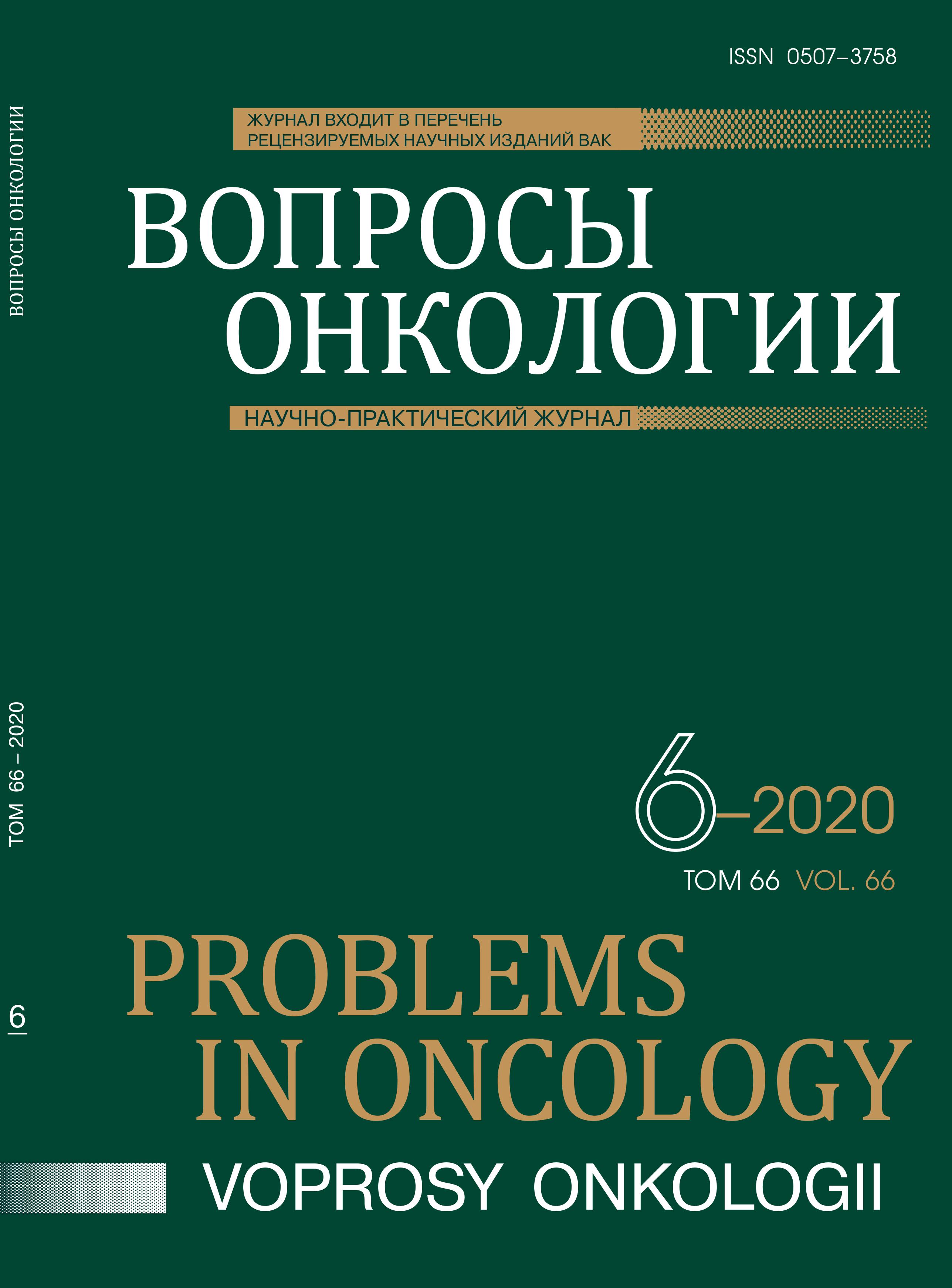Abstract
The purpose was to study antitumor effects of the group K rotaviruses strains No. 228 and No. 100 in the experiment on a model of transplantable murine melanoma.
Material and methods. The study included 65 С57Black/6 mice with transplantable B16/F10 melanoma and two strains of the Reoviridae family members characterized as rotaviruses, not belonging to the known groups, with the working title “group K rotaviruses (RVK)”. Animals received RVK in “vaccination” (before tumor transplantation) and “treatment” (after tumor formation) modes. Live and inactivated strains were used. RVK were administered intramuscularly as 0.3 ml of virus-containing culture fluid with at least 5x109 viral particles per 1 ml, with a total of 4 injections. Life span of mice and morphological characteristics of tumors were evaluated.
Results. Injections of both strains increased the survival of tumor-bearing mice by 1.7-1.9 times in 4 of 8 experimental groups, compared to controls. The modes of RVK administration showed some differences: the survival was longer in mice with the “vaccination” mode compared to the “treatment” mode. Morphological changes in tumors were similar after application of both modes and inclued dystrophic changes of tumor cells, formation of extensive necrosis areas, and leukocyte infiltration.
Discussion. Live and inactivated RVK had unidirectional effects implying its association with immunomodulatory action rather than with a direct lytic effect on the tumor.
Conclusions. Both studied strains of rotaviruses in the group K had antitumor effect in the model of transplantable В16/F10 murine melanoma in the «vaccination» mode.
References
Woller N., Gürlevik E., Ureche C-I. et al. Oncolytic viruses as anticancer vaccines. Front. Oncol. 2014;4:188. doi: 10.3389/fonc.2014.00188.
Bartlett D.L., Liu Z., Sathaiah M. et al. Oncolytic viruses as therapeutic cancer vaccines. Mol. Cancer. 2013;12:103. doi:10.1186/1476-4598-12-103.
Schirrmacher V. Fifty years of clinical application of Newcastle disease virus: time to celebrate. Biomedicines. 2016;4(3):16.
Breitbach C.J., Lichty B.D., Bell J.C. Oncolytic viruses: therapeutics with an identity crisis. EBioMedicine. 2016;9:31–6.
Ситковская А.О., Златник Е.Ю., Новикова И.А., Кит О.И. Вирус болезни Ньюкасла и иммунитет - эффективный альянс в борьбе против рака (обзор литературы). Сибирский онкологический журнал. 2018;6(6):105-113. doi: 10.21294/1814-4861-2018-17-6-105-113 [Sitkovskaya A.O., Zlatnik Е.YU., Novikova I.A., Kit O.I. Newcastle disease virus and the immune system - an effective Alliance in the fight against cancer (review of literature). Sibirskijonkologicheskijzhurnal. 2018;6(6):105-113. doi: 10.21294/1814-4861-2018-17-6-105-113 (In Russ.)].
Шурыгина А.-П.С., Карташев А.В., Кованько Е.Г. и др. Онколитический потенциал рекомбинантных векторов вируса гриппа а на модели злокачественной глиомы invivo. Вопросы Онкологии. 2016;62(1):138-45 [Shurygina A.-P.S., Kartashev A.V., Kovan'ko Е.G. et al. Oncolytic potential of recombinant vectors of influenza a virus on the model of malignant glioma in vivo. Voprosy Onkologii. 2016;62(1):138-45 (In Russ.)].
Eissa I., Bustos-Villalobos I., Ichinose T. et al. The Current Status and Future Prospects of Oncolytic Viruses in Clinical Trials against Melanoma, Glioma, Pancreatic, and Breast Cancers. Cancers. 2018;10(10):356.
Wang B., Song L., Ma D. et al. Progress in Newcastle disease virus against tumor. Chinese journal of biotechnology. 2018;34(9):1432-41.
Alberts P., Olmane E., Brokane L. et al. Long term treatment with the oncolytic ECHO‐7 virus Rigvir of a melanoma stage IV M1c patient, a small cell lung cancer stage IIIA patient, and a histiocytic sarcoma stage IV patient three case reports. Apmis. 2016;34(10):896-904.
Garber K. China approves world's first oncolytic virus therapy for cancer treatment. Journal of the National Cancer Institute. 2006;98(5):298-300.
Kaufman H.L., Bines S.D. OPTIM trial: a Phase III trial of an oncolytic herpes virus encoding GM-CSF for unresectable stage III or IV melanoma. Future Oncol. 2010;6:941–9. doi:10.2217/fon.10.66.
Kalica A.R., Sereno M.M., Wyatt R.C. et al. Comparison of human and animal rotavirus strains by gel electrophoresis of viral RNA. Virology. 1978;87:247-55.
Almeida J.D., Hall T., Banatwola J.E. et al. The effect of trypsin on the growth of rotavirus. J. Gen. Virol. 1978;40:213-9.
Колпаков С.А., Колпакова Е.П. Адаптация штаммов ротавируса человека группы А к репродукции на перевиваемых культурах клеток. Вопросы вирусологии. 2017;62(3):38-43 [Kolpakov S.A., Kolpakova Е.P. Adaptation of human rotavirus strains of group A to reproduction on transplanted cell cultures. Voprosyvirusologii. 2017;62(3):38-43 (In Russ.)].
Колпаков С.А., Колпакова Е.П. Новая группа ротавирусов человека семейства Reoviridae. Живые и биокосные системы. 2014;10 [Kolpakov S.A., Kolpakova Е.P. A new group of human rotaviruses of the family Reoviridae. ZHivyeibiokosnyesistemy. 2014;10 (In Russ.)].
Златник Е.Ю., Ситковская А.О., Шульгина О.Г. и др. Влияние вируса болезни Ньюкасла на показатели клеточного иммунитета крыс-опухоленосителей (экспериментальное исследование). Современные проблемы науки и образования. 2018;4:240 [Zlatnik Е.YU., Sitkovskaya A.O., Shul'gina O.G. et al. The influence of the virus of Newcastle disease on the indicators of cellular immunity of rats, tumours (pilot study). Sovremennyeproblemynaukiiobrazovaniya. 2018;4:240 (In Russ.)].
Колпаков С.А., Колпакова Е.П. Неклассифицированные вирусы человека семейства Reoviridae // Сб. конф. Актуальные вопросы диагностики и профилактики инфекционных и паразитарных заболеваний на юге России. Материалы межрегиональной научно-практической конференции с международным участием. 2016:243-7 [Kolpakov S.A., Kolpakova Е.P. Unclassified human viruses of the Reoviridae family // Sb. konf. Aktual'nyevoprosydiagnostikiiprofilaktikiinfekcionnyhiparazitarnyhzabolevanijnayugeRossii. Materialymezhregional'nojnauchno-prakticheskojkonferencii s mezhdunarodnymuchastiem. 2016:243-7 (In Russ.)].
Workenhe S.T., Mossman K.L. Oncolytic virotherapy and immunogenic cancer cell death: sharpening the sword for improved cancer treatment strategies. MolTher. 2014;22:251–6. doi:10.1038/mt.2013.220.
Guo Z.S., Liu Z., Bartlett D.L. Oncolytic immunotherapy: dying the right way is a key to eliciting potent antitumor immunity. Front Oncol. 2014;4:74. doi:10.3389/fonc.2014.00074.
Kroemer G., Galluzzi L., Kepp O., Zitvogel L. Immunogenic cell death in cancer therapy. Annu Rev Immunol. 2013;31:51–72. doi:10.1146/annurev-immunol-032712-100008.
Garg A.D., Krysko D.V., Verfaillie T. et al. A novel pathway combining calreticulin exposure and ATP secretion in immunogenic cancer cell death. EMBO J. 2012;31:1062–79. doi:10.1038/emboj.2011.497.
Kepp O., Menger L., Vacchelli E. et al. Crosstalk between ER stress and immunogenic cell death. Cytokine Growth Factor Rev. 2013;24:311–8. doi:10.1016/j.cytogfr.2013.05.001.
Tang D., Kang R., Coyne C.B. et al. PAMPs and DAMPs: signal 0s that spur autophagy and immunity. ImmunolRev. 2012;249:158–75. doi:10.1111/j.1600-065X.2012.01146.x.
Meng C., Zhou Z., Jiang K. et al. Newcastle disease virus triggers autophagy in U251 glioma cells to enhance virus replication. Arch Virol. 2012;157:1011–8. doi:10.1007/s00705-012-1270-6.
Bridle B.W., Clouthier D., Zhang L. Oncolytic vesicular stomatitis virus quantitatively and qualitatively improves primary CD8 T-cell responses to anticancer vaccines. Oncoimmunology. 2013;2:e26013. doi:10.4161/onci.26013.

This work is licensed under a Creative Commons Attribution-NonCommercial-NoDerivatives 4.0 International License.
© АННМО «Вопросы онкологии», Copyright (c) 2020
